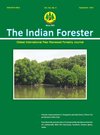Tree Diversity and Structure of a Tropical Dry Deciduous Forest in Sri Lankamalla Wildlife Sanctuary, Southern Eastern Ghats, India
DOI:
https://doi.org/10.36808/if/2016/v142i9/102515Keywords:
Dry Deciduous Forests, Rank Abundance Curve, Importance Value Index, Population Structure, Sri Lankamalla Wildlife Sanctuary.Abstract
Tropical dry forests are the dominant and threatened forest ecosystems in India. Species richness, diversity, importance value index of tree species of tree species were analysed in Sri Lankamalla dry deciduous forest of southern Eastern Ghats. All trees≥30 cm gbh were enumerated in plain and hill slopes of the sanctuary in two hectare area. A total of 1994 tree individuals that belongs to 35 families and 73 genera were recorded. Euphorbiaceae was the dominant family comprising of 11 species. The Shannon index value of 2.9 indicates a moderate level of species richness. Few tree species dominated the forests, the top twenty species had recorded 77% of tree individuals and 54% comprised of density of less than ten individuals per ha. Pterocarpus santalinus, Hardwickia binata and Anogeissus latifolia were the dominant tree species. The population structure of the dominant tree Pterocarpus santalinus has abundance of individuals in lower size classes probably due to selective logging. The topographical features such as plain and hill slope areas has helped in increasing the tree diversity.References
Adekunle V.A.J., Olagoke A.O. and Akindele S.A. (2013). Tree species diversity and structure of a Nigerian strict nature reserve., Tropical Ecology, 54 (3):275-289.
Bond W.J. and Midgle J.J. (2001). Ecology of sprouting in woody plants: the persistence niche. Trends in Ecology and Evolution, 16: 45-51.
Champion H.G. and Seth S.K. (1968). A Revised Survey of the forest types of India, Govt of India Press. N. Delhi.
Chaturvedi R.K., Raghubanshi A.S. and Singh J.S. (2011). Effect of small-scale variations in Environmental factors on the distribution of woody species in Tropical Deciduous forests of Vindhyan Highlands. India. J. Botany, 1:1-10.
Coelho M.S., Almada E.D., Quintino A.V., Fernandes G.W., Santos R.M., Sanchez-Azofeifa G.A. and Santo M.M.D.E. (2012). Floristic composition and structure of a Tropical dry forest at different successional stages in the Espinhaco mountains, southeastern Brazil. Interciencia, 37: 190-196.
Cottom G. and Curtis J.T. (1956). The use of distance measures in phytosociological sampling. Ecology, 37: 451-460.
Gillespie T.W., Grijalva A. and Farris C.N. (2000). Diversity, composition and structure of tropical dry forests in Central America. Plant Ecology, 147: 37-47.
Killeen T.J., Jardim A., Mamani F. and Rojas N. (1998). Diversity, composition and structure of a tropical semideciduous forest in the Chiquitania region of Santa Cruz, Bolivia. J. Tropical Ecology, 14: 803-827.
Longhi S.J., Araujo M.M., Kelling M.B., Hoppe J.M., Miller I. Borsoi G.A. (2000). Phytosociological aspects of a fragment of deciduous seasonal forest. R.S. Ciencia Florestal, Santa Maria, 10: 59-74.
Magurran A. (1988). Ecological diversity and Measurement. Princeton University Press, New Jersey.
Murphy P.G. and Lugo A.E. (1986). Ecology of tropical dry forests. Annual Review Ecology and Systematics, 17: 67-88.
Kumar N., J.I. Kumar R.N., Bhoi R.K. and Sajish P.R. (2011). Tree species diversity and soil nutrient status in three sites of tropical dry deciduous forest of western India. Tropical Ecology, 51 (2): 273-279.
Powers J.S., Becknell J.M., Irving J. and Perez-Aviles D. (2009). Diversity and structure of regenerating tropical dry forests in Costa Rica: Geographic patterns and environmental drivers. Forest Ecology and Management,258: 959-970.
Rawat G.S. (1997). Conservation status of forests and wildlife in the Eastern Ghats, India. Environmental Conservation, 24 (4): 307-315.
Sagar R. and Singh J.S. (2005). Structure, diversity and regeneration of tropical dry deciduous forest of northern India. Biodiversity and Conservation, 14: 935-959.
Sagar R., Raghubanshi A.S. and Singh J.S. (2003). Tree species composition, dispersion and diversity along a disturbance gradient in a tropical forest region of India. Forest Ecology and Management,186: 61-71.
Sanchez-Azofeifa G.A., Kalacska M. Quesada M. Nassar J. and Rodriguez J.P. (2005). Need a for integrated research for sustainable future in tropical dry forest. Conservation Biology, 19: 285-286.
Sukumar R., Dattaraja H.S., Suresh H.S., Radhakrishna R., Vasudeva S. Nirmala and Joshi N.V. (1992). Long-term monitoring of vegetation in a tropical deciduous forest in Mudumalai, southern India. Current Science, 84: 608-610.
Yadav A.S. and Gupta S.K. (2006). Effect of micro-environment and human disturbance on the diversity of woody species in the Sariska Tiger Project in India. Forest Ecology and Management, 225: 178-189.
Zar J.H. (1984). Biostatistical analysis. 2nd edition. Princeton-Hall. New Jersey.
Downloads
Downloads
Published
How to Cite
Issue
Section
License
Unless otherwise stated, copyright or similar rights in all materials presented on the site, including graphical images, are owned by Indian Forester.





